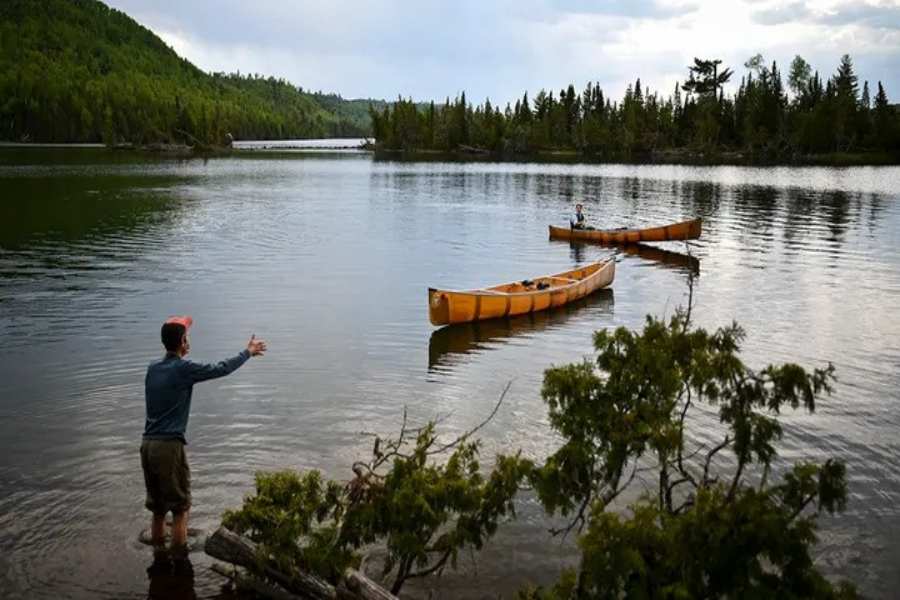
The serene expanse of the Boundary Waters Canoe Area in northern Minnesota, renowned for its breathtaking landscapes and tranquil waters, was tragically transformed into a scene of sorrow last Friday.
The body of 62-year-old Mark Ham from Duluth was discovered in a grim testament to the perils of neglecting water safety. Found partly submerged near his overturned canoe by fellow canoeists who promptly alerted authorities, Ham’s death serves as a poignant reminder of the critical importance of safety measures in outdoor recreational activities.
Mark Ham, an enthusiast of the great outdoors, had embarked on a solo camping trip, planning to traverse the tranquil waters of the Boundary Waters Canoe Area. This popular destination, located about 25 miles north of Ely, Minnesota, and close to the Ontario border, attracts numerous nature lovers and canoeing aficionados each year. However, Ham’s adventure took a fatal turn when he decided to go canoeing alone without a life jacket—a decision that proved catastrophic.
Upon discovery of the accident around 5 p.m., the scene described by first responders painted a chilling picture: Ham’s canoe capsized, with his life jacket found unused at the scene. This detail is particularly harrowing given the statistics from the U.S. Centers for Disease Control and Prevention, which highlight that drowning is a leading cause of unintentional death, disproportionately affecting men who account for 80% of such fatalities.
The St. Louis County Sheriff’s Office, along with the Midwest Medical Examiner’s Office, promptly began investigating the circumstances surrounding Ham’s demise. As the community reels from this tragedy, the incident underscores the relentless hazards present in water-based activities and the non-negotiable need for strict adherence to safety protocols.
This tragic event coincided with the opening weekend of Minnesota’s fishing season, a period that saw a surge in water-related activities. In response to the incident, local authorities issued a stern reminder about the necessity of wearing life jackets. “As we kick off the fishing season, it’s crucial that everyone engaging in water recreation not only wears a life jacket but also follows all safety guidelines to prevent such needless tragedies,” a spokesperson for the sheriff’s office stated emphatically.
The reminder came not just from a place of authority but also concern, as demonstrated by the juxtaposition of Ham’s death with another recent water-related fatality. Just a week prior, a 20-year-old man drowned while heroically attempting to save a companion in Tennessee, further emphasizing the unpredictable and dangerous nature of aquatic environments.
The local community and visitors to the Boundary Waters Canoe Area are now faced with a stark reminder of the importance of safety measures. The sheriff’s office, along with rescue squads, is intensifying efforts to educate the public about the dangers of water activities, especially stressing the importance of not venturing into waters alone and ensuring all safety gear is functional and properly utilized.
These efforts are crucial as the warmer months attract more individuals to engage in outdoor activities, heightening the risk of accidents. Safety campaigns are being planned, focusing on awareness and training to equip individuals with the necessary knowledge and skills to safely enjoy water-based recreation. Authorities are also considering stricter enforcement of safety regulations to ensure compliance and prevent further incidents.
The impact of Ham’s untimely death resonates beyond immediate family and friends, touching a broader community that shares a love for the outdoors but may not fully appreciate the inherent risks. Educational programs targeting schools and local clubs are being developed to instill a culture of safety among young enthusiasts and seasoned adventurers alike.
As the investigation into Ham’s death continues, the narrative emerging calls for a collective reevaluation of how individuals engage with nature’s offerings. It’s a call that demands attention not only from those who frequent the Boundary Waters but from anyone who seeks solace or adventure in natural settings. The legacy of this tragedy, if it can be said to have one, should be a marked improvement in safety standards and practices, ensuring that the natural beauty of places like the Boundary Waters can be safely appreciated by all.
In memory of Mark Ham, and in the shadow of this tragedy, the community and authorities alike stand resolute in their commitment to fostering safer recreational environments. It’s a necessary step toward safeguarding the lives of countless individuals who seek rejuvenation and adventure in the embrace of nature, ensuring that such losses are not repeated and that the joys of outdoor activities are not overshadowed by preventable tragedies.








